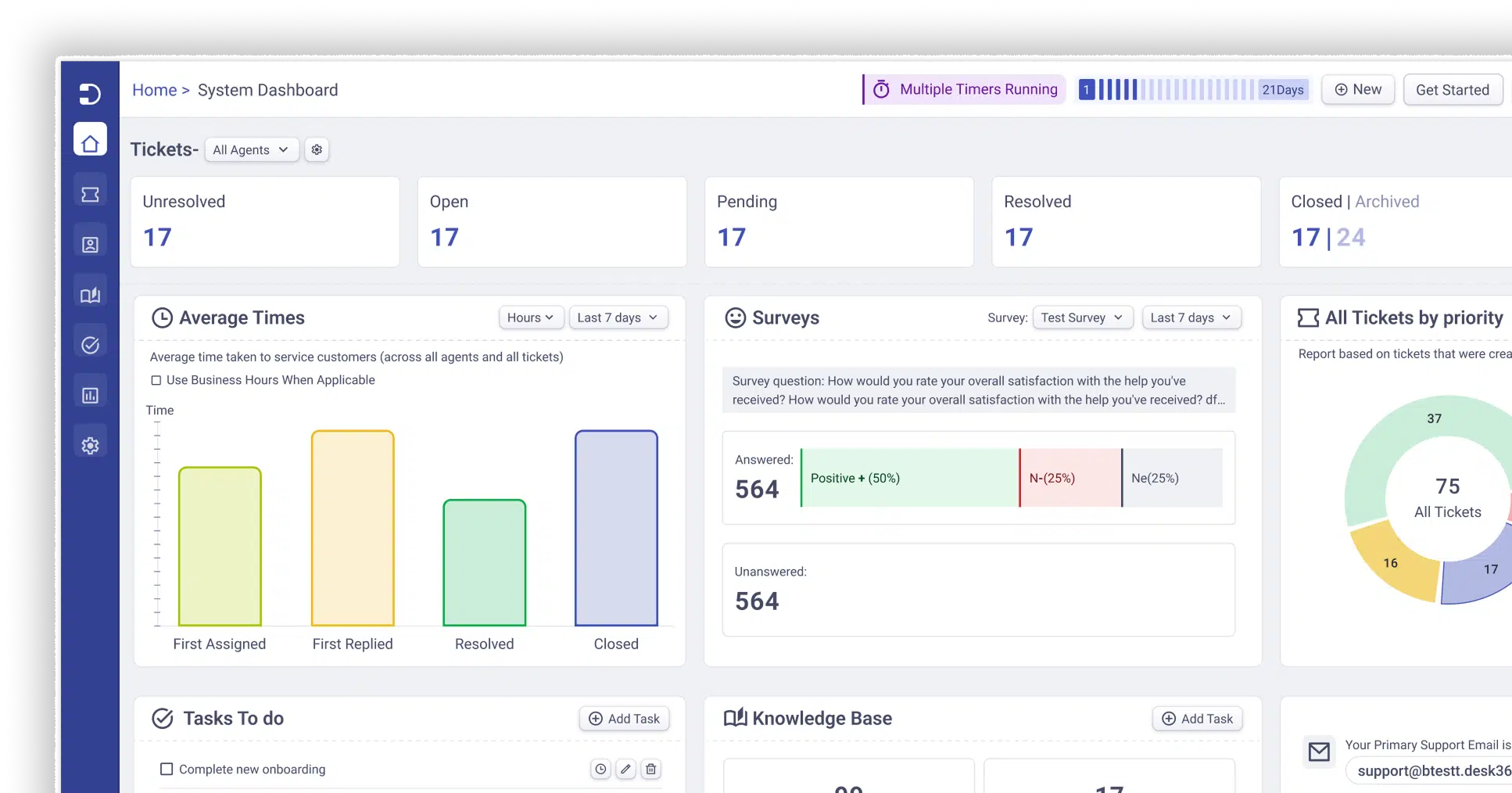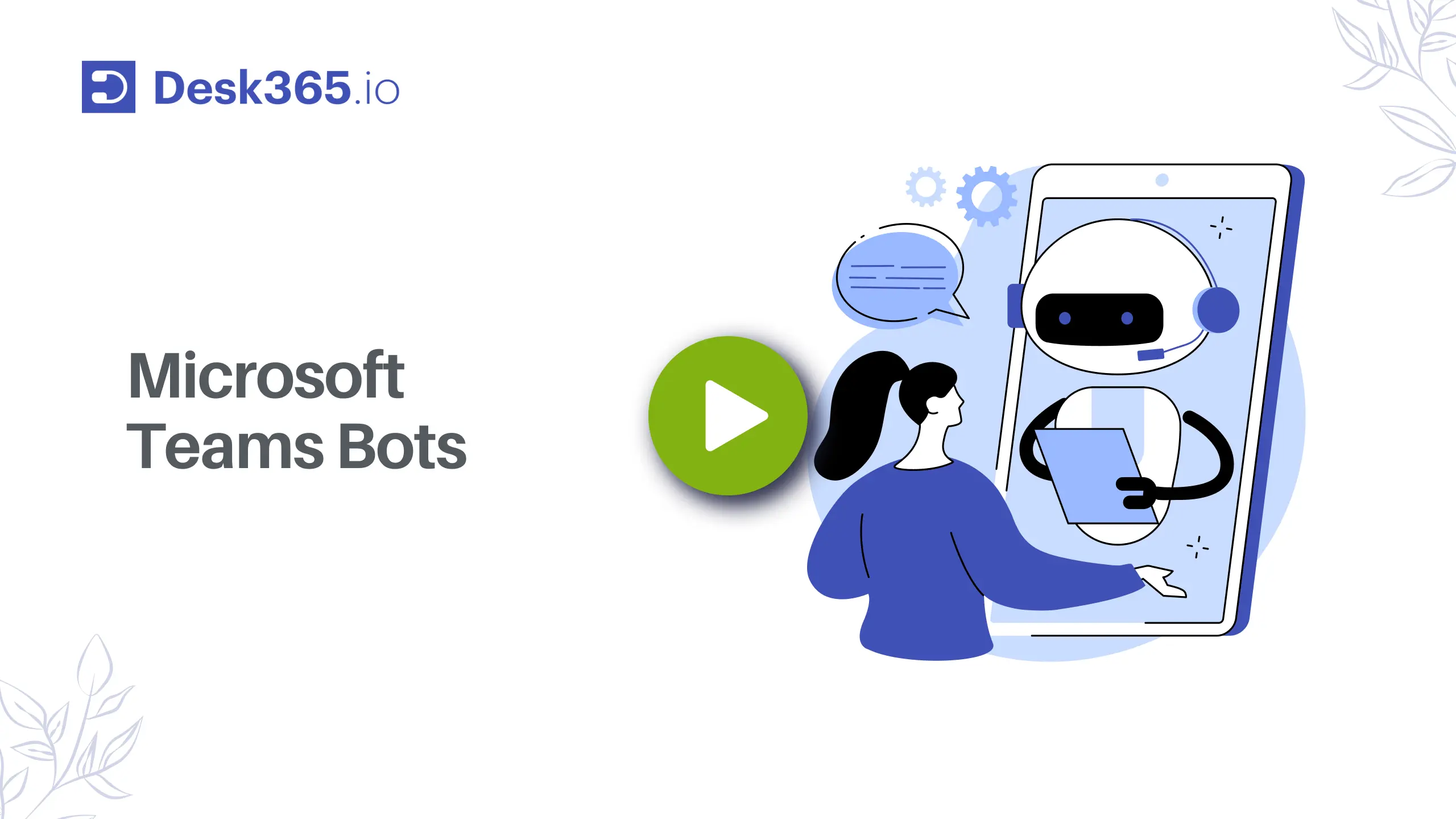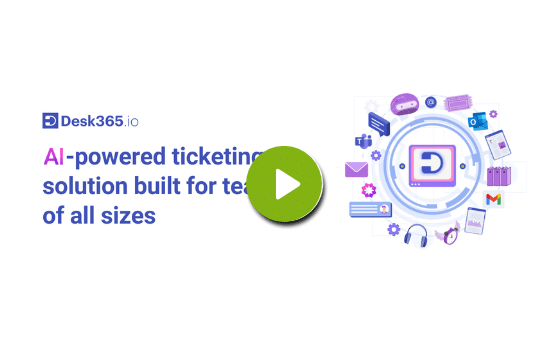Real-time support has become an essential part of modern customer service, and conversational ticketing is emerging as a game-changer in this space.
Conversational ticketing can be provided by support agents or by employing specialized bots within collaboration platforms such as Microsoft Teams and Slack.
The term ‘conversational ticketing’ is derived from the fact that opening a ticket is as simple as having a conversation or sending a message. It is a streamlined process that allows employees to create, manage, and reply back on tickets seamlessly.
With platforms like Microsoft Teams and Slack, businesses can now provide real-time support by treating conversations as tickets. But just how popular are these collaboration tools?
According to recent data, Microsoft Teams has surpassed 320 million daily active users, while Slack has more than 20 million daily active users. Moreover, among Fortune 500 companies, 91% of them are using Microsoft Teams, while 9% are using Slack.
By bringing the power of an entire ticket management system into messaging platforms like Microsoft Teams and Slack, conversational ticketing allows support teams to provide efficient and effective customer support.
In this article, we will delve into the concept of conversational ticketing, its benefits, implementation strategies, and explore why it is the future of customer support.
What is conversational ticketing?
Conversational ticketing is a real-time support system that allows users to communicate with support professionals through chat platforms like Teams or Slack, allowing internal employees and support staffs to create, manage, and comment on tickets seamlessly.
Conversational ticketing is also known as conversational support, conversational service, Slack, or Microsoft Teams ticketing.
It enables businesses to centralize and streamline customer interactions by converting conversations into tickets. These tickets are then routed to the appropriate teams or agents for resolution.
This system streamlines support by helping employees where they’re already working, making it easy to get the help they need without having to switch between different platforms.
Conversational ticketing vs traditional ticketing systems
Conversational ticketing is an emerging trend in the field of support and IT helpdesk. It is a modern way of organizing team communication and tackling support tickets more effectively. Conversational ticketing is becoming increasingly popular because it offers several benefits over traditional ticketing systems.
Traditional ticketing systems are designed to manage customer support requests through a ticketing system. When a customer has an issue, they submit a ticket, and wait for a response, and support teams have to manually sort and prioritize incoming requests.
Conversational ticketing, on the other hand, is designed to provide real-time support to the users. This means that support agents can respond to user queries and issues instantly, improve the customer response time, and overall improve the user experience.
Conversational ticketing also allows support agents to have a conversation with users, which can help to build a rapport and establish a personal connection.
Another reason why conversational ticketing is becoming popular is that it is integrated with collaboration platforms like Microsoft Teams. This means that support agents can manage incoming requests within these platforms, which can save time and improve efficiency.
While traditional ticketing systems, including email ticketing, remain widely used, conversational ticketing is becoming increasingly popular due to its ability to provide fast and personalized customer support.
Also, these systems can be enhanced with AI and other technologies to provide even more personalized support, making it a valuable tool for businesses looking to improve their customer support experience.
Benefits of conversational ticketing
Conversational ticketing is a new approach to customer support that streamlines the ticketing workflow into a messaging system. It allows employees and agents to create, manage, and comment on tickets seamlessly, making it faster, more efficient, and more productive. Here are some of the benefits of conversational ticketing:
Improving resolution times
Conversational ticketing helps improve resolution times by providing real-time support to users. This means that agents can respond to users’ queries in real-time, reducing the time it takes to resolve tickets. This is particularly useful for urgent issues that require immediate attention.
Efficient ticket management
Conversational ticketing systems provide centralized ticket management, allowing support agents to handle multiple conversations simultaneously. They can efficiently prioritize, assign, and track tickets, ensuring that every customer query is addressed promptly.
Lower cost of operation
By leveraging helpdesk automation and real-time support, conversational ticketing can significantly reduce the cost of operation for businesses. With fewer manual processes and more efficient support operations, businesses can save time and money while improving customer satisfaction.
Reduce the gap between ticketing system and collaboration platforms
Conversational ticketing brings support to where people work by integrating with collaboration platforms such as Slack, Microsoft Teams, and others. This means that users can access support directly from their work environment, without the need to switch between different applications.
Break communication silos
Conversational ticketing breaks communication silos by providing a unified platform for communication between agents and users. This ensures that all issues are resolved in a timely and efficient manner, without the need for manual intervention. With conversational ticketing, businesses can break down communication silos and enable cross-functional collaboration.
Provide 24×7 internal support
Conversational ticketing enables businesses to provide 24×7 internal support by leveraging chat platforms like Microsoft Teams. With real-time support and automation, businesses can handle internal support requests more efficiently and provide employees with timely assistance. This means that support is available round the clock, ensuring that all issues are resolved in a timely and efficient manner.
Challenges of conversational ticketing
Conversational ticketing may come with its own set of challenges. Here are some common challenges:
Require additional skills and training
Conversational ticketing requires a different set of skills than traditional email ticketing. Support agents need to be able to provide real-time support, manage multiple conversations simultaneously, and use chat platforms effectively. To ensure that support teams have the necessary skills, businesses need to provide comprehensive training and ongoing support to their agents.
Tracking a fast influx of support tickets
One of the biggest challenges of conversational ticketing is keeping up with the fast inflow of tickets. To handle this volume, businesses need to have the right technology and automation in place. This includes employing powerful bots as well as automation features that can handle repetitive tasks, route requests to the right support agent, and provide customers with quick and accurate responses. By leveraging technology and automation, businesses can improve their support operations and provide a more seamless customer experience.
Limitations of collaboration platforms
Collaboration platforms like Slack or Teams may not have the all the necessary features which makes it difficult to manage support requests effectively. To overcome these limitations, it’s important to choose a conversational ticketing platform that is specifically designed for platform like Microsoft Teams.
Look for a platform that has robust automation and integrations, as well as features like ticket management and reporting. And make sure the platform is easy to use and accessible to all members of your support team, regardless of their location or device.
This is where Desk365 fits in perfectly well. It seamlessly integrates with Microsoft Teams, enabling effective collaboration between support agents and employees within the Microsoft Teams environment.
Best practices for conversational support
Conversational ticketing is a valuable tool for providing real-time support to customers and employees. However, to get the most out of this technology, it is important to follow best practices for conversational support.
Promote self-service with a solid knowledge base
One of the best ways to reduce the number of support requests is to promote self-service through a strong knowledge base. A knowledge base is a collection of articles, FAQs, and other resources that can help customers and employees find the answers they need without having to contact support.
By providing easy access to a knowledge base, companies can reduce the number of support requests and improve customer satisfaction. With Desk365, you can have access to a robust knowledge base, can easily track ticket status, and perform various customer support tasks within Teams without needing to switch platforms.
Read more – How to Set Up knowledge Base in Microsoft Teams?
Train employees on how to use conversational ticketing
Conversational ticketing is a new technology, and it is important to train employees on how to use it effectively. This includes training on how to respond to support requests, how to escalate issues, and how to use the ticketing system. By providing comprehensive training, companies can ensure that employees are using the technology effectively and providing the best possible support to customers.
Track important metrics
To ensure that conversational support is working effectively, it is important to track important metrics. This includes metrics such as response time, resolution time, and customer satisfaction. By tracking these metrics, companies can identify areas for improvement and make data-driven decisions about their support strategy.
Desk365, a conversational ticketing system, has a robust reporting module that enables effortless tracking of all these metrics.
Read more – 12 Best Helpdesk Metrics to Measure in 2025
Seamless ticketing flow in both directions
Conversational ticketing should be a seamless experience for both your customers and your support team. This means that customers or employees should be able to create, manage, and comment on tickets seamlessly within the messaging system. This ensures that all relevant information is captured in the ticketing system and that everyone involved in the support request has access to the same information.
Keep it simple
Finally, it is important to keep conversational support simple. This means that the messaging system should be easy to use, and support requests should be easy to create and manage. By keeping things simple, companies can ensure that customers and employees are more likely to use the system and that support requests are resolved quickly and effectively.
Conversational ticketing systems like Desk365 feature an intuitive user interface that ensures simplicity in its usage, making it easily accessible for both your support team and internal employees. This enables them to utilize Teams as a seamless ticketing channel.
How to set up conversational ticketing using Desk365 in Microsoft Teams
Microsoft Teams is a collaboration platform that allows users to chat, call, and collaborate on projects. It is also a popular platform for conversational ticketing. With conversational ticketing on Microsoft Teams, support agents and bots can provide real-time support to users within the platform.
This means that support agents can create, manage, and comment on tickets seamlessly, optimizing productivity and handling issues from start to solved in a single conversation.
Desk365 offers conversational ticketing for Microsoft Teams, enabling seamless communication and management of support requests for both employees and helpdesk agents within the Teams platform. This ensures an efficient and seamless helpdesk experience directly within Microsoft Teams.
The best part is, if you are already using the Microsoft 365 environment, you won’t need to install any additional external software.
To install Desk365, simply follow these steps:
1. If you already have Microsoft Teams set up for your organization, you can install Desk365 from the Microsoft App Store in just a few minutes.
2. Desk365 offers two specialized bots: the Desk365 Agent Bot for Microsoft Teams and the Desk365 Support Bot for Microsoft Teams.
The Agent Bot allows support staff to manage tickets, update statuses, and change ticket properties directly within Microsoft Teams. This bot is only available to company agents and is free to download from Microsoft AppSource.
With the Desk365 Agent Bot, your IT Support team can reply to tickets, check on statuses, change ticket properties, and do more, directly in Microsoft Teams. This bot is available only for agents of the company.
The Support Bot enables contatcs (users, employees, customers, end- users, students) to create tickets, check statuses, and communicate with agents from within Microsoft Teams. You can customize the Support Bot to match your brand guidelines. To use the Support Bot, you’ll need to download it and sideload it for your contacts.
You can also customize the Support Bot to match your brand guidelines. Internal employees can easily create new tickets and collaborate with your support team directly within the familiar Microsoft Teams environment.
To use the Support Bot, you’ll need to download it and sideload it for your contacts.
For a comprehensive guide on how to install both the Agent Bot and Support Bot, refer to the detailed instructions provided.
Enjoy the benefits of streamlined ticketing and enhanced support right within Microsoft Teams!
Frequently asked questions
Conversational ticketing allows users to manage support tickets through chat platforms like Microsoft Teams, enabling real-time communication and seamless ticket handling.
Conversational ticketing improves resolution speed, reduces operational costs, breaks down communication silos, and integrates support within existing work platforms.
Desk365 offers specialized bots for seamless ticket management and user support directly within Microsoft Teams.
Yes! Desk365 offers a 21-day free trial to help you explore its customer service solutions and enhance your email support.











